Case Study: Deteriorating Patient - Hypovolemic Shock in Nursing 3
VerifiedAdded on 2022/11/29
|9
|2910
|91
Essay
AI Summary
This essay examines a case study of a 67-year-old man, Kenneth Bradman, admitted to a surgical high dependency unit with hypovolemic shock. The essay identifies and discusses two key signs of clinical deterioration: rapid heart rate and respiration. It then identifies rapid heart rate as the priority problem, justifying its clinical significance. Two nursing interventions are discussed to address the rapid heart rate: vagal maneuvers, medication, cardioversion, and catheter ablation, including how to evaluate their effectiveness. The essay also addresses the psychosocial issue of substance abuse, specifically ethanol misuse, and discusses the role of detoxification in managing this issue. The essay concludes by summarizing the healthcare practices that can be adopted to manage Bradman’s hypovolemic shock condition and the significance of the interventions and psychosocial considerations.
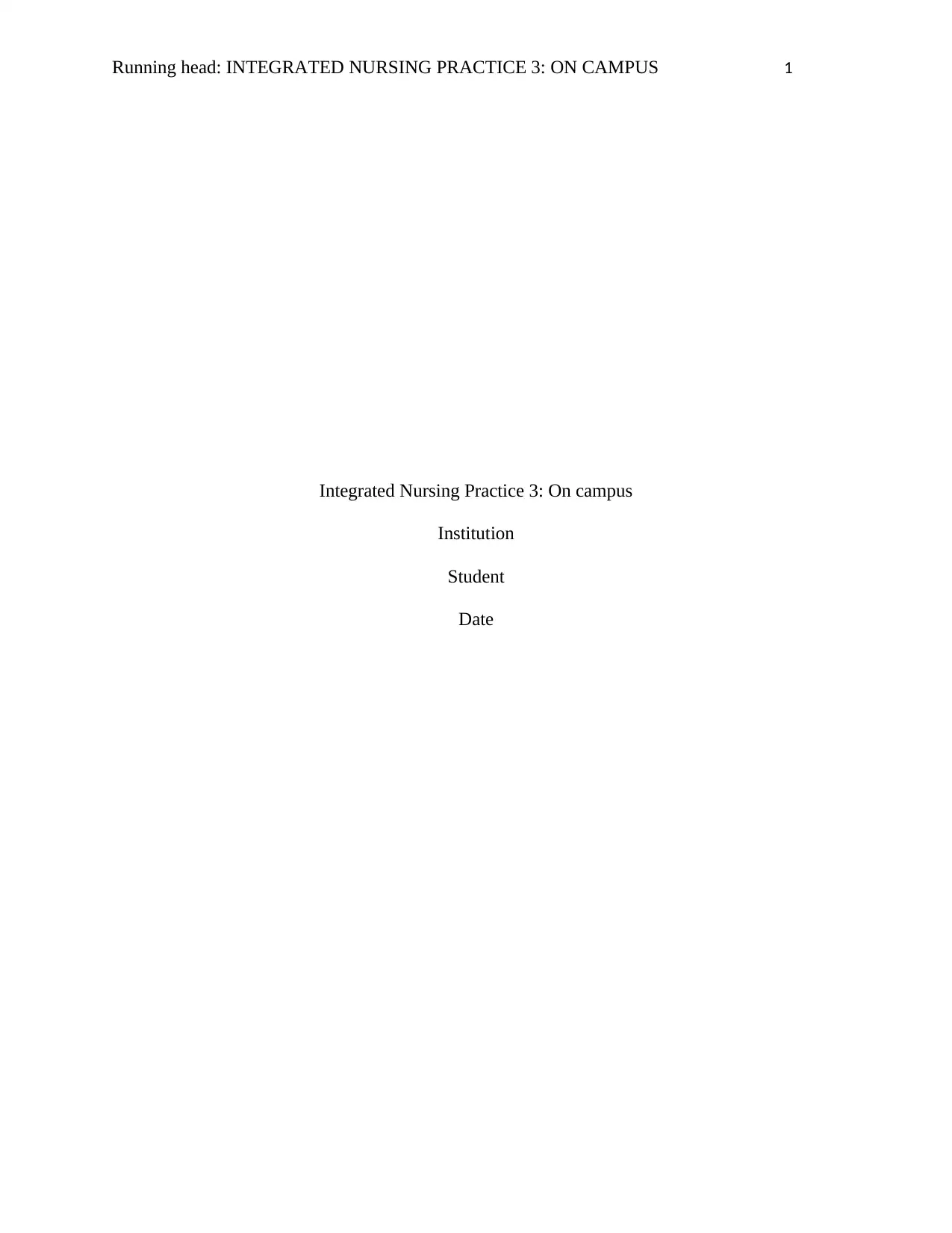
Running head: INTEGRATED NURSING PRACTICE 3: ON CAMPUS 1
Integrated Nursing Practice 3: On campus
Institution
Student
Date
Integrated Nursing Practice 3: On campus
Institution
Student
Date
Paraphrase This Document
Need a fresh take? Get an instant paraphrase of this document with our AI Paraphraser
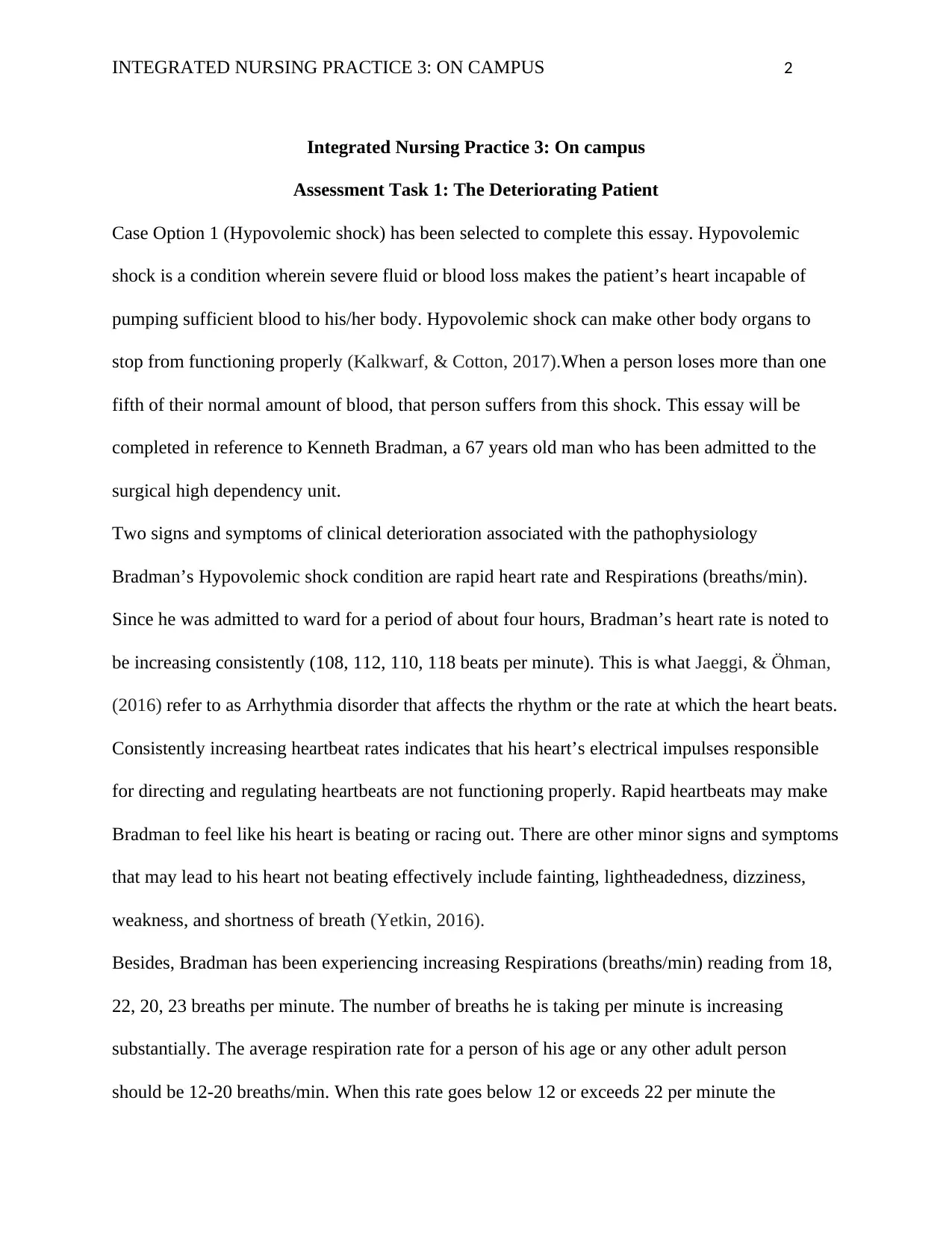
INTEGRATED NURSING PRACTICE 3: ON CAMPUS 2
Integrated Nursing Practice 3: On campus
Assessment Task 1: The Deteriorating Patient
Case Option 1 (Hypovolemic shock) has been selected to complete this essay. Hypovolemic
shock is a condition wherein severe fluid or blood loss makes the patient’s heart incapable of
pumping sufficient blood to his/her body. Hypovolemic shock can make other body organs to
stop from functioning properly (Kalkwarf, & Cotton, 2017).When a person loses more than one
fifth of their normal amount of blood, that person suffers from this shock. This essay will be
completed in reference to Kenneth Bradman, a 67 years old man who has been admitted to the
surgical high dependency unit.
Two signs and symptoms of clinical deterioration associated with the pathophysiology
Bradman’s Hypovolemic shock condition are rapid heart rate and Respirations (breaths/min).
Since he was admitted to ward for a period of about four hours, Bradman’s heart rate is noted to
be increasing consistently (108, 112, 110, 118 beats per minute). This is what Jaeggi, & Öhman,
(2016) refer to as Arrhythmia disorder that affects the rhythm or the rate at which the heart beats.
Consistently increasing heartbeat rates indicates that his heart’s electrical impulses responsible
for directing and regulating heartbeats are not functioning properly. Rapid heartbeats may make
Bradman to feel like his heart is beating or racing out. There are other minor signs and symptoms
that may lead to his heart not beating effectively include fainting, lightheadedness, dizziness,
weakness, and shortness of breath (Yetkin, 2016).
Besides, Bradman has been experiencing increasing Respirations (breaths/min) reading from 18,
22, 20, 23 breaths per minute. The number of breaths he is taking per minute is increasing
substantially. The average respiration rate for a person of his age or any other adult person
should be 12-20 breaths/min. When this rate goes below 12 or exceeds 22 per minute the
Integrated Nursing Practice 3: On campus
Assessment Task 1: The Deteriorating Patient
Case Option 1 (Hypovolemic shock) has been selected to complete this essay. Hypovolemic
shock is a condition wherein severe fluid or blood loss makes the patient’s heart incapable of
pumping sufficient blood to his/her body. Hypovolemic shock can make other body organs to
stop from functioning properly (Kalkwarf, & Cotton, 2017).When a person loses more than one
fifth of their normal amount of blood, that person suffers from this shock. This essay will be
completed in reference to Kenneth Bradman, a 67 years old man who has been admitted to the
surgical high dependency unit.
Two signs and symptoms of clinical deterioration associated with the pathophysiology
Bradman’s Hypovolemic shock condition are rapid heart rate and Respirations (breaths/min).
Since he was admitted to ward for a period of about four hours, Bradman’s heart rate is noted to
be increasing consistently (108, 112, 110, 118 beats per minute). This is what Jaeggi, & Öhman,
(2016) refer to as Arrhythmia disorder that affects the rhythm or the rate at which the heart beats.
Consistently increasing heartbeat rates indicates that his heart’s electrical impulses responsible
for directing and regulating heartbeats are not functioning properly. Rapid heartbeats may make
Bradman to feel like his heart is beating or racing out. There are other minor signs and symptoms
that may lead to his heart not beating effectively include fainting, lightheadedness, dizziness,
weakness, and shortness of breath (Yetkin, 2016).
Besides, Bradman has been experiencing increasing Respirations (breaths/min) reading from 18,
22, 20, 23 breaths per minute. The number of breaths he is taking per minute is increasing
substantially. The average respiration rate for a person of his age or any other adult person
should be 12-20 breaths/min. When this rate goes below 12 or exceeds 22 per minute the
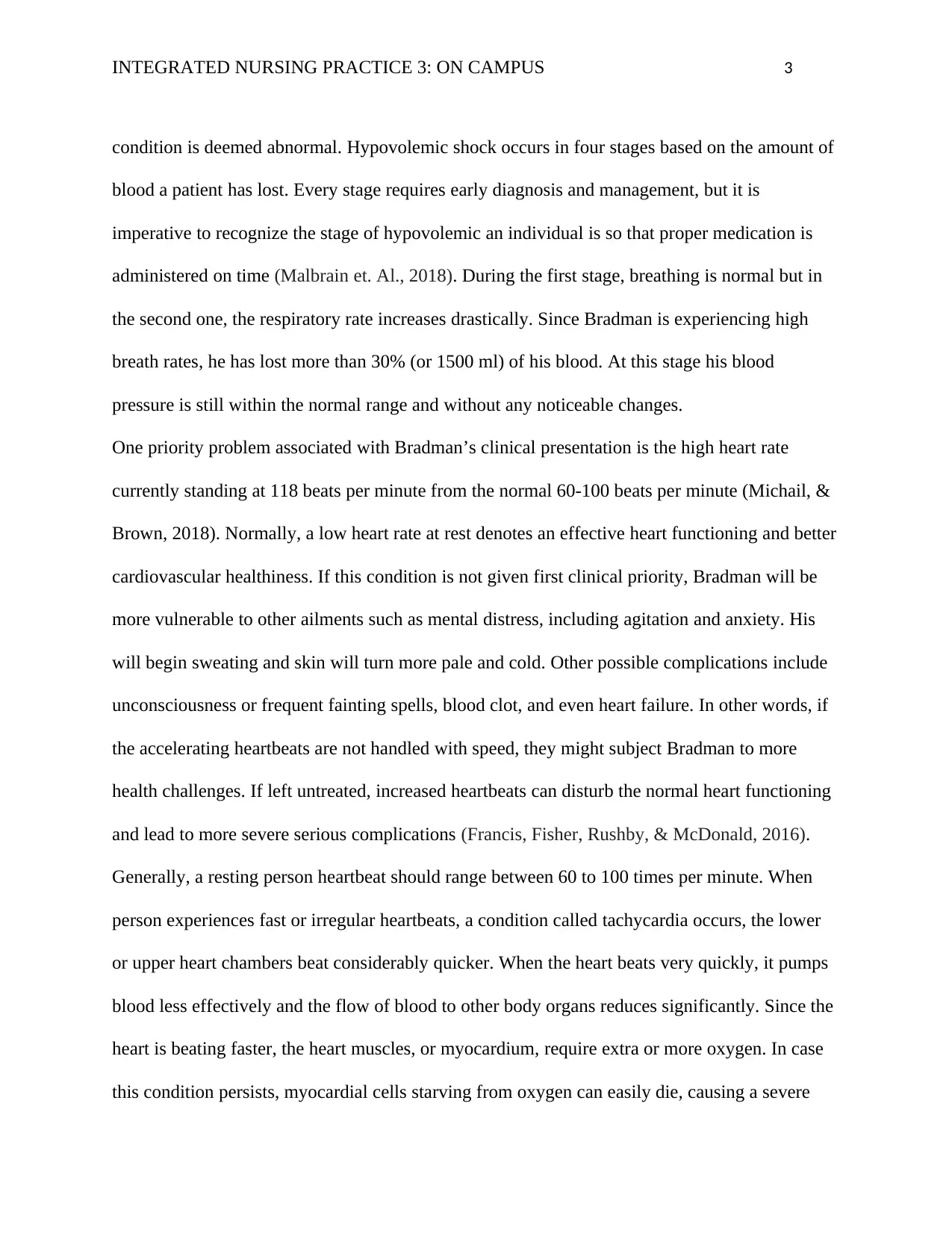
INTEGRATED NURSING PRACTICE 3: ON CAMPUS 3
condition is deemed abnormal. Hypovolemic shock occurs in four stages based on the amount of
blood a patient has lost. Every stage requires early diagnosis and management, but it is
imperative to recognize the stage of hypovolemic an individual is so that proper medication is
administered on time (Malbrain et. Al., 2018). During the first stage, breathing is normal but in
the second one, the respiratory rate increases drastically. Since Bradman is experiencing high
breath rates, he has lost more than 30% (or 1500 ml) of his blood. At this stage his blood
pressure is still within the normal range and without any noticeable changes.
One priority problem associated with Bradman’s clinical presentation is the high heart rate
currently standing at 118 beats per minute from the normal 60-100 beats per minute (Michail, &
Brown, 2018). Normally, a low heart rate at rest denotes an effective heart functioning and better
cardiovascular healthiness. If this condition is not given first clinical priority, Bradman will be
more vulnerable to other ailments such as mental distress, including agitation and anxiety. His
will begin sweating and skin will turn more pale and cold. Other possible complications include
unconsciousness or frequent fainting spells, blood clot, and even heart failure. In other words, if
the accelerating heartbeats are not handled with speed, they might subject Bradman to more
health challenges. If left untreated, increased heartbeats can disturb the normal heart functioning
and lead to more severe serious complications (Francis, Fisher, Rushby, & McDonald, 2016).
Generally, a resting person heartbeat should range between 60 to 100 times per minute. When
person experiences fast or irregular heartbeats, a condition called tachycardia occurs, the lower
or upper heart chambers beat considerably quicker. When the heart beats very quickly, it pumps
blood less effectively and the flow of blood to other body organs reduces significantly. Since the
heart is beating faster, the heart muscles, or myocardium, require extra or more oxygen. In case
this condition persists, myocardial cells starving from oxygen can easily die, causing a severe
condition is deemed abnormal. Hypovolemic shock occurs in four stages based on the amount of
blood a patient has lost. Every stage requires early diagnosis and management, but it is
imperative to recognize the stage of hypovolemic an individual is so that proper medication is
administered on time (Malbrain et. Al., 2018). During the first stage, breathing is normal but in
the second one, the respiratory rate increases drastically. Since Bradman is experiencing high
breath rates, he has lost more than 30% (or 1500 ml) of his blood. At this stage his blood
pressure is still within the normal range and without any noticeable changes.
One priority problem associated with Bradman’s clinical presentation is the high heart rate
currently standing at 118 beats per minute from the normal 60-100 beats per minute (Michail, &
Brown, 2018). Normally, a low heart rate at rest denotes an effective heart functioning and better
cardiovascular healthiness. If this condition is not given first clinical priority, Bradman will be
more vulnerable to other ailments such as mental distress, including agitation and anxiety. His
will begin sweating and skin will turn more pale and cold. Other possible complications include
unconsciousness or frequent fainting spells, blood clot, and even heart failure. In other words, if
the accelerating heartbeats are not handled with speed, they might subject Bradman to more
health challenges. If left untreated, increased heartbeats can disturb the normal heart functioning
and lead to more severe serious complications (Francis, Fisher, Rushby, & McDonald, 2016).
Generally, a resting person heartbeat should range between 60 to 100 times per minute. When
person experiences fast or irregular heartbeats, a condition called tachycardia occurs, the lower
or upper heart chambers beat considerably quicker. When the heart beats very quickly, it pumps
blood less effectively and the flow of blood to other body organs reduces significantly. Since the
heart is beating faster, the heart muscles, or myocardium, require extra or more oxygen. In case
this condition persists, myocardial cells starving from oxygen can easily die, causing a severe
⊘ This is a preview!⊘
Do you want full access?
Subscribe today to unlock all pages.

Trusted by 1+ million students worldwide
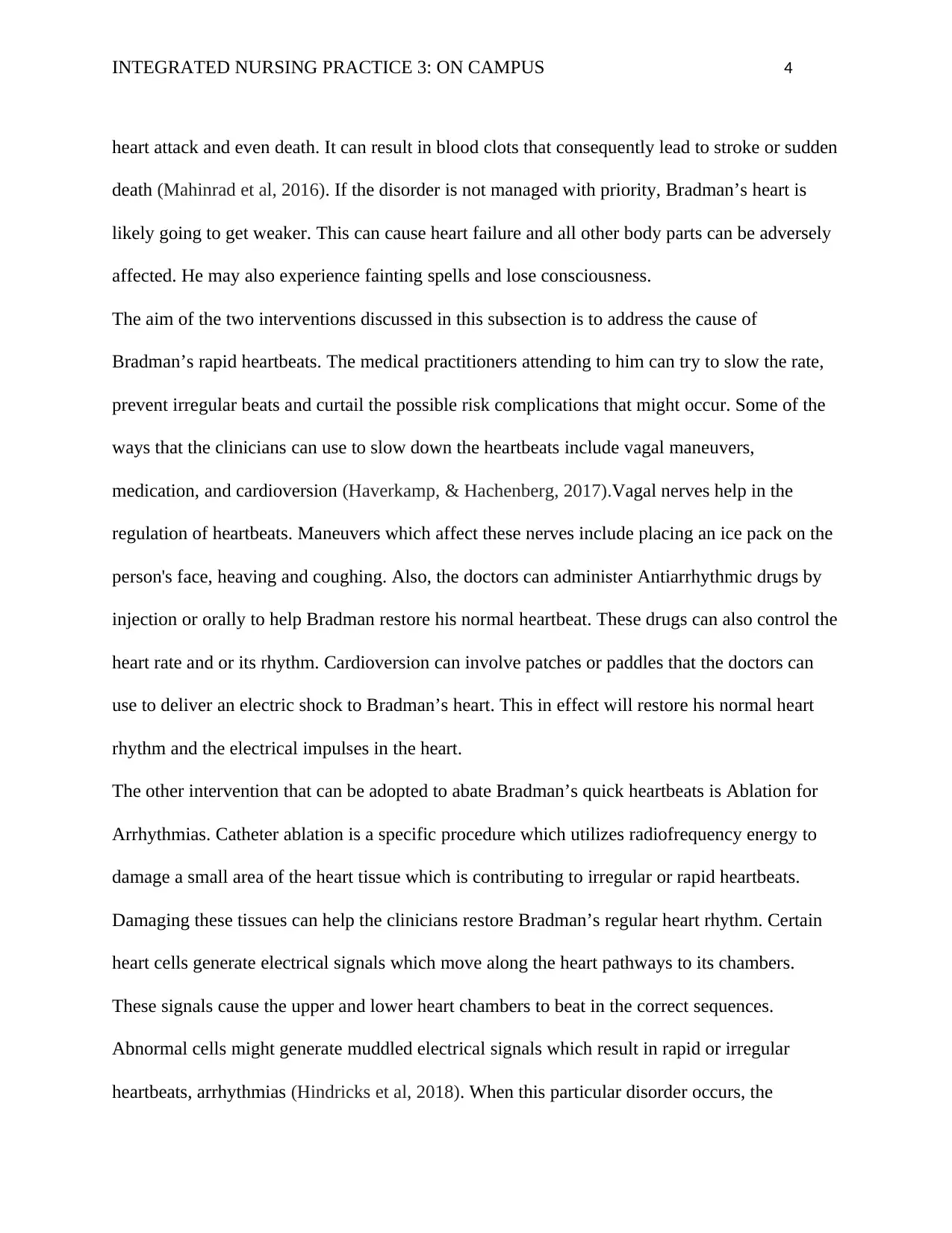
INTEGRATED NURSING PRACTICE 3: ON CAMPUS 4
heart attack and even death. It can result in blood clots that consequently lead to stroke or sudden
death (Mahinrad et al, 2016). If the disorder is not managed with priority, Bradman’s heart is
likely going to get weaker. This can cause heart failure and all other body parts can be adversely
affected. He may also experience fainting spells and lose consciousness.
The aim of the two interventions discussed in this subsection is to address the cause of
Bradman’s rapid heartbeats. The medical practitioners attending to him can try to slow the rate,
prevent irregular beats and curtail the possible risk complications that might occur. Some of the
ways that the clinicians can use to slow down the heartbeats include vagal maneuvers,
medication, and cardioversion (Haverkamp, & Hachenberg, 2017).Vagal nerves help in the
regulation of heartbeats. Maneuvers which affect these nerves include placing an ice pack on the
person's face, heaving and coughing. Also, the doctors can administer Antiarrhythmic drugs by
injection or orally to help Bradman restore his normal heartbeat. These drugs can also control the
heart rate and or its rhythm. Cardioversion can involve patches or paddles that the doctors can
use to deliver an electric shock to Bradman’s heart. This in effect will restore his normal heart
rhythm and the electrical impulses in the heart.
The other intervention that can be adopted to abate Bradman’s quick heartbeats is Ablation for
Arrhythmias. Catheter ablation is a specific procedure which utilizes radiofrequency energy to
damage a small area of the heart tissue which is contributing to irregular or rapid heartbeats.
Damaging these tissues can help the clinicians restore Bradman’s regular heart rhythm. Certain
heart cells generate electrical signals which move along the heart pathways to its chambers.
These signals cause the upper and lower heart chambers to beat in the correct sequences.
Abnormal cells might generate muddled electrical signals which result in rapid or irregular
heartbeats, arrhythmias (Hindricks et al, 2018). When this particular disorder occurs, the
heart attack and even death. It can result in blood clots that consequently lead to stroke or sudden
death (Mahinrad et al, 2016). If the disorder is not managed with priority, Bradman’s heart is
likely going to get weaker. This can cause heart failure and all other body parts can be adversely
affected. He may also experience fainting spells and lose consciousness.
The aim of the two interventions discussed in this subsection is to address the cause of
Bradman’s rapid heartbeats. The medical practitioners attending to him can try to slow the rate,
prevent irregular beats and curtail the possible risk complications that might occur. Some of the
ways that the clinicians can use to slow down the heartbeats include vagal maneuvers,
medication, and cardioversion (Haverkamp, & Hachenberg, 2017).Vagal nerves help in the
regulation of heartbeats. Maneuvers which affect these nerves include placing an ice pack on the
person's face, heaving and coughing. Also, the doctors can administer Antiarrhythmic drugs by
injection or orally to help Bradman restore his normal heartbeat. These drugs can also control the
heart rate and or its rhythm. Cardioversion can involve patches or paddles that the doctors can
use to deliver an electric shock to Bradman’s heart. This in effect will restore his normal heart
rhythm and the electrical impulses in the heart.
The other intervention that can be adopted to abate Bradman’s quick heartbeats is Ablation for
Arrhythmias. Catheter ablation is a specific procedure which utilizes radiofrequency energy to
damage a small area of the heart tissue which is contributing to irregular or rapid heartbeats.
Damaging these tissues can help the clinicians restore Bradman’s regular heart rhythm. Certain
heart cells generate electrical signals which move along the heart pathways to its chambers.
These signals cause the upper and lower heart chambers to beat in the correct sequences.
Abnormal cells might generate muddled electrical signals which result in rapid or irregular
heartbeats, arrhythmias (Hindricks et al, 2018). When this particular disorder occurs, the
Paraphrase This Document
Need a fresh take? Get an instant paraphrase of this document with our AI Paraphraser
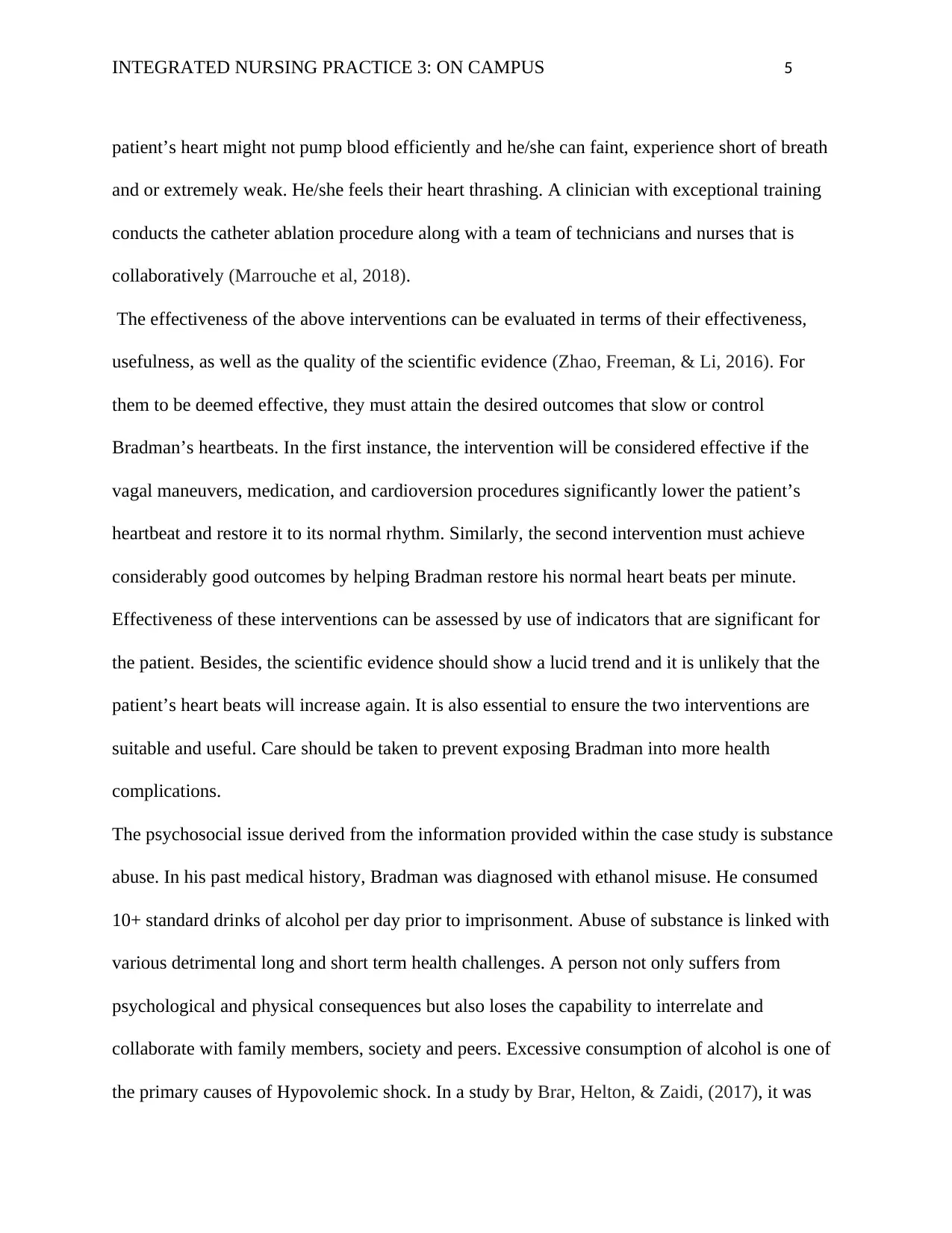
INTEGRATED NURSING PRACTICE 3: ON CAMPUS 5
patient’s heart might not pump blood efficiently and he/she can faint, experience short of breath
and or extremely weak. He/she feels their heart thrashing. A clinician with exceptional training
conducts the catheter ablation procedure along with a team of technicians and nurses that is
collaboratively (Marrouche et al, 2018).
The effectiveness of the above interventions can be evaluated in terms of their effectiveness,
usefulness, as well as the quality of the scientific evidence (Zhao, Freeman, & Li, 2016). For
them to be deemed effective, they must attain the desired outcomes that slow or control
Bradman’s heartbeats. In the first instance, the intervention will be considered effective if the
vagal maneuvers, medication, and cardioversion procedures significantly lower the patient’s
heartbeat and restore it to its normal rhythm. Similarly, the second intervention must achieve
considerably good outcomes by helping Bradman restore his normal heart beats per minute.
Effectiveness of these interventions can be assessed by use of indicators that are significant for
the patient. Besides, the scientific evidence should show a lucid trend and it is unlikely that the
patient’s heart beats will increase again. It is also essential to ensure the two interventions are
suitable and useful. Care should be taken to prevent exposing Bradman into more health
complications.
The psychosocial issue derived from the information provided within the case study is substance
abuse. In his past medical history, Bradman was diagnosed with ethanol misuse. He consumed
10+ standard drinks of alcohol per day prior to imprisonment. Abuse of substance is linked with
various detrimental long and short term health challenges. A person not only suffers from
psychological and physical consequences but also loses the capability to interrelate and
collaborate with family members, society and peers. Excessive consumption of alcohol is one of
the primary causes of Hypovolemic shock. In a study by Brar, Helton, & Zaidi, (2017), it was
patient’s heart might not pump blood efficiently and he/she can faint, experience short of breath
and or extremely weak. He/she feels their heart thrashing. A clinician with exceptional training
conducts the catheter ablation procedure along with a team of technicians and nurses that is
collaboratively (Marrouche et al, 2018).
The effectiveness of the above interventions can be evaluated in terms of their effectiveness,
usefulness, as well as the quality of the scientific evidence (Zhao, Freeman, & Li, 2016). For
them to be deemed effective, they must attain the desired outcomes that slow or control
Bradman’s heartbeats. In the first instance, the intervention will be considered effective if the
vagal maneuvers, medication, and cardioversion procedures significantly lower the patient’s
heartbeat and restore it to its normal rhythm. Similarly, the second intervention must achieve
considerably good outcomes by helping Bradman restore his normal heart beats per minute.
Effectiveness of these interventions can be assessed by use of indicators that are significant for
the patient. Besides, the scientific evidence should show a lucid trend and it is unlikely that the
patient’s heart beats will increase again. It is also essential to ensure the two interventions are
suitable and useful. Care should be taken to prevent exposing Bradman into more health
complications.
The psychosocial issue derived from the information provided within the case study is substance
abuse. In his past medical history, Bradman was diagnosed with ethanol misuse. He consumed
10+ standard drinks of alcohol per day prior to imprisonment. Abuse of substance is linked with
various detrimental long and short term health challenges. A person not only suffers from
psychological and physical consequences but also loses the capability to interrelate and
collaborate with family members, society and peers. Excessive consumption of alcohol is one of
the primary causes of Hypovolemic shock. In a study by Brar, Helton, & Zaidi, (2017), it was
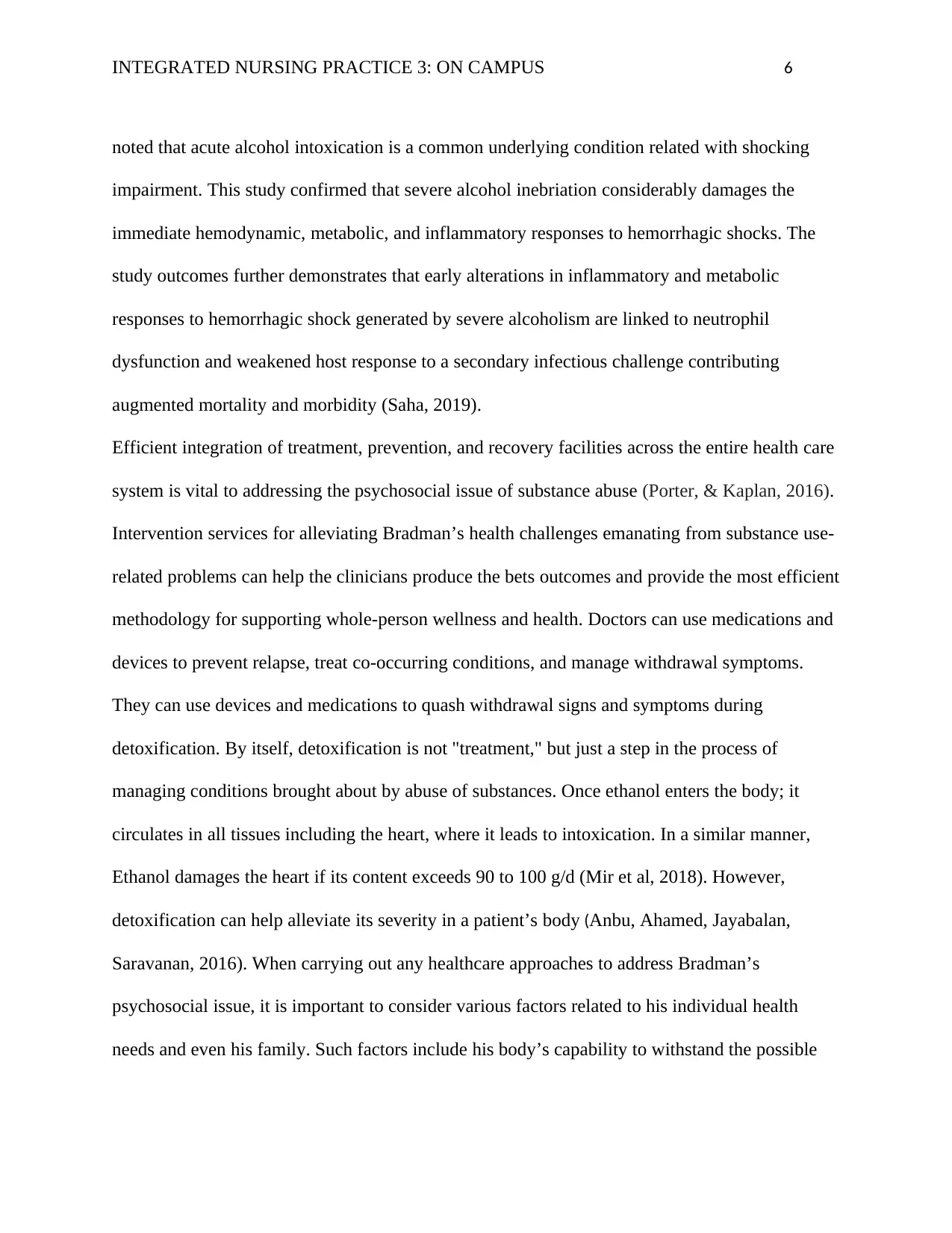
INTEGRATED NURSING PRACTICE 3: ON CAMPUS 6
noted that acute alcohol intoxication is a common underlying condition related with shocking
impairment. This study confirmed that severe alcohol inebriation considerably damages the
immediate hemodynamic, metabolic, and inflammatory responses to hemorrhagic shocks. The
study outcomes further demonstrates that early alterations in inflammatory and metabolic
responses to hemorrhagic shock generated by severe alcoholism are linked to neutrophil
dysfunction and weakened host response to a secondary infectious challenge contributing
augmented mortality and morbidity (Saha, 2019).
Efficient integration of treatment, prevention, and recovery facilities across the entire health care
system is vital to addressing the psychosocial issue of substance abuse (Porter, & Kaplan, 2016).
Intervention services for alleviating Bradman’s health challenges emanating from substance use-
related problems can help the clinicians produce the bets outcomes and provide the most efficient
methodology for supporting whole-person wellness and health. Doctors can use medications and
devices to prevent relapse, treat co-occurring conditions, and manage withdrawal symptoms.
They can use devices and medications to quash withdrawal signs and symptoms during
detoxification. By itself, detoxification is not "treatment," but just a step in the process of
managing conditions brought about by abuse of substances. Once ethanol enters the body; it
circulates in all tissues including the heart, where it leads to intoxication. In a similar manner,
Ethanol damages the heart if its content exceeds 90 to 100 g/d (Mir et al, 2018). However,
detoxification can help alleviate its severity in a patient’s body (Anbu, Ahamed, Jayabalan,
Saravanan, 2016). When carrying out any healthcare approaches to address Bradman’s
psychosocial issue, it is important to consider various factors related to his individual health
needs and even his family. Such factors include his body’s capability to withstand the possible
noted that acute alcohol intoxication is a common underlying condition related with shocking
impairment. This study confirmed that severe alcohol inebriation considerably damages the
immediate hemodynamic, metabolic, and inflammatory responses to hemorrhagic shocks. The
study outcomes further demonstrates that early alterations in inflammatory and metabolic
responses to hemorrhagic shock generated by severe alcoholism are linked to neutrophil
dysfunction and weakened host response to a secondary infectious challenge contributing
augmented mortality and morbidity (Saha, 2019).
Efficient integration of treatment, prevention, and recovery facilities across the entire health care
system is vital to addressing the psychosocial issue of substance abuse (Porter, & Kaplan, 2016).
Intervention services for alleviating Bradman’s health challenges emanating from substance use-
related problems can help the clinicians produce the bets outcomes and provide the most efficient
methodology for supporting whole-person wellness and health. Doctors can use medications and
devices to prevent relapse, treat co-occurring conditions, and manage withdrawal symptoms.
They can use devices and medications to quash withdrawal signs and symptoms during
detoxification. By itself, detoxification is not "treatment," but just a step in the process of
managing conditions brought about by abuse of substances. Once ethanol enters the body; it
circulates in all tissues including the heart, where it leads to intoxication. In a similar manner,
Ethanol damages the heart if its content exceeds 90 to 100 g/d (Mir et al, 2018). However,
detoxification can help alleviate its severity in a patient’s body (Anbu, Ahamed, Jayabalan,
Saravanan, 2016). When carrying out any healthcare approaches to address Bradman’s
psychosocial issue, it is important to consider various factors related to his individual health
needs and even his family. Such factors include his body’s capability to withstand the possible
⊘ This is a preview!⊘
Do you want full access?
Subscribe today to unlock all pages.

Trusted by 1+ million students worldwide
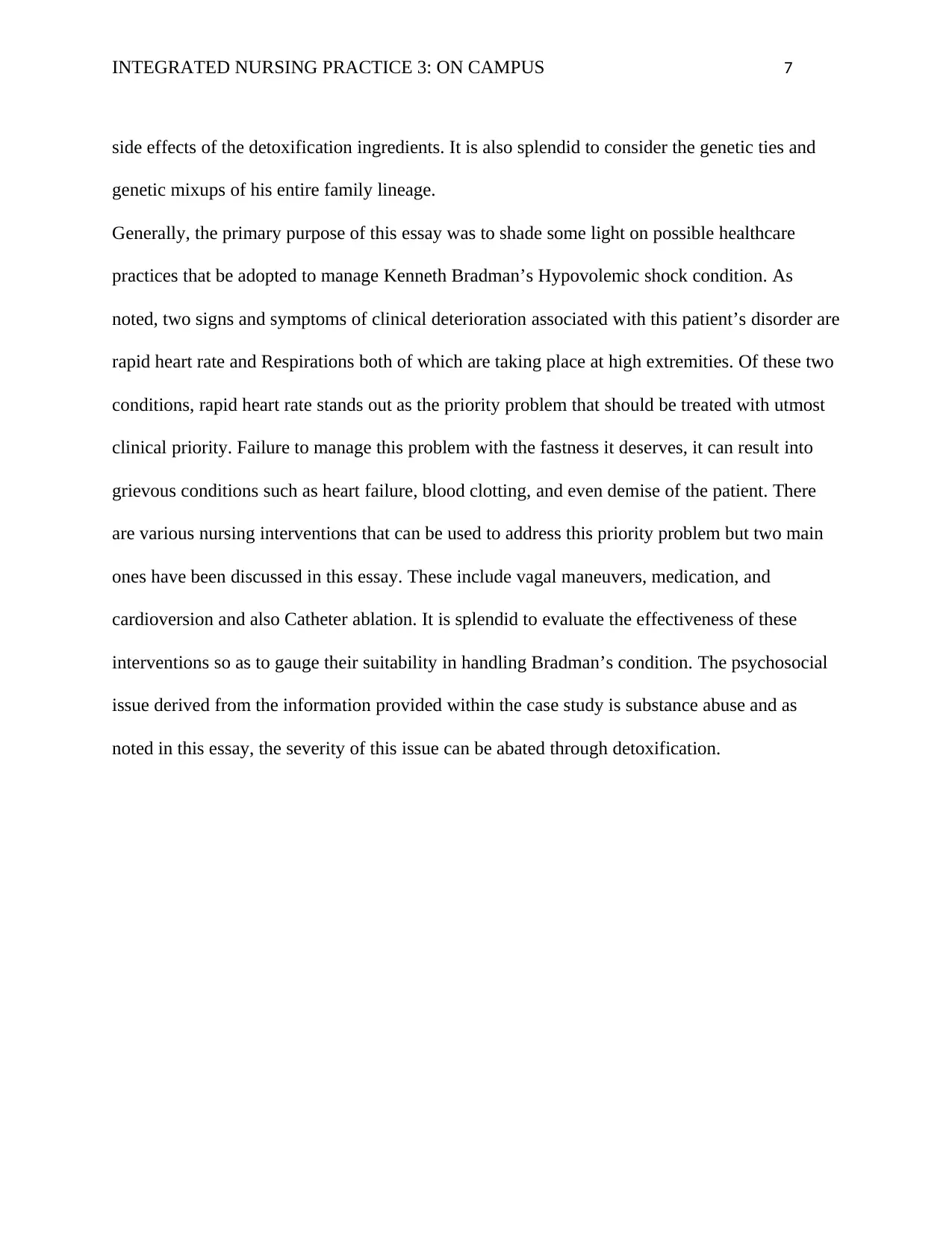
INTEGRATED NURSING PRACTICE 3: ON CAMPUS 7
side effects of the detoxification ingredients. It is also splendid to consider the genetic ties and
genetic mixups of his entire family lineage.
Generally, the primary purpose of this essay was to shade some light on possible healthcare
practices that be adopted to manage Kenneth Bradman’s Hypovolemic shock condition. As
noted, two signs and symptoms of clinical deterioration associated with this patient’s disorder are
rapid heart rate and Respirations both of which are taking place at high extremities. Of these two
conditions, rapid heart rate stands out as the priority problem that should be treated with utmost
clinical priority. Failure to manage this problem with the fastness it deserves, it can result into
grievous conditions such as heart failure, blood clotting, and even demise of the patient. There
are various nursing interventions that can be used to address this priority problem but two main
ones have been discussed in this essay. These include vagal maneuvers, medication, and
cardioversion and also Catheter ablation. It is splendid to evaluate the effectiveness of these
interventions so as to gauge their suitability in handling Bradman’s condition. The psychosocial
issue derived from the information provided within the case study is substance abuse and as
noted in this essay, the severity of this issue can be abated through detoxification.
side effects of the detoxification ingredients. It is also splendid to consider the genetic ties and
genetic mixups of his entire family lineage.
Generally, the primary purpose of this essay was to shade some light on possible healthcare
practices that be adopted to manage Kenneth Bradman’s Hypovolemic shock condition. As
noted, two signs and symptoms of clinical deterioration associated with this patient’s disorder are
rapid heart rate and Respirations both of which are taking place at high extremities. Of these two
conditions, rapid heart rate stands out as the priority problem that should be treated with utmost
clinical priority. Failure to manage this problem with the fastness it deserves, it can result into
grievous conditions such as heart failure, blood clotting, and even demise of the patient. There
are various nursing interventions that can be used to address this priority problem but two main
ones have been discussed in this essay. These include vagal maneuvers, medication, and
cardioversion and also Catheter ablation. It is splendid to evaluate the effectiveness of these
interventions so as to gauge their suitability in handling Bradman’s condition. The psychosocial
issue derived from the information provided within the case study is substance abuse and as
noted in this essay, the severity of this issue can be abated through detoxification.
Paraphrase This Document
Need a fresh take? Get an instant paraphrase of this document with our AI Paraphraser
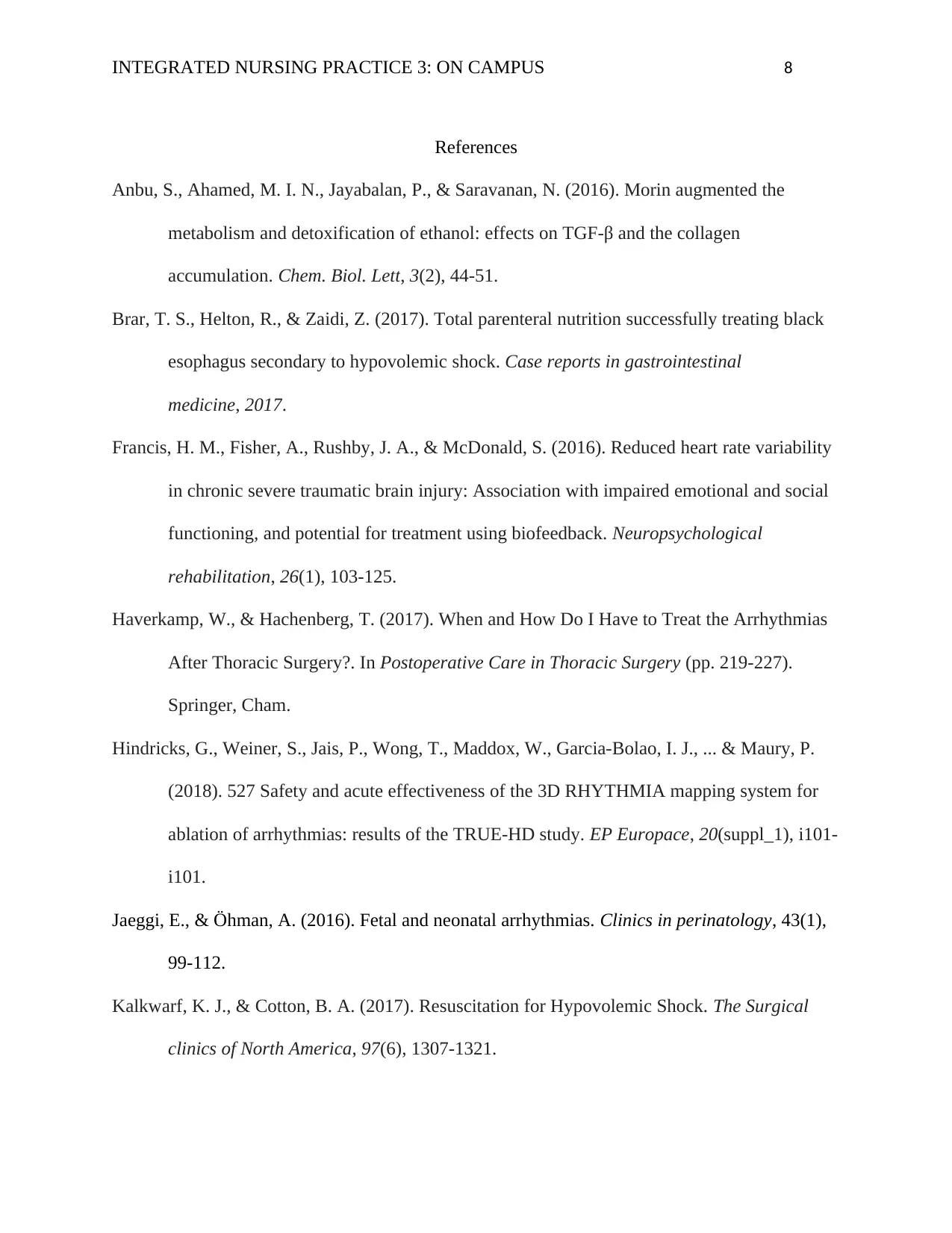
INTEGRATED NURSING PRACTICE 3: ON CAMPUS 8
References
Anbu, S., Ahamed, M. I. N., Jayabalan, P., & Saravanan, N. (2016). Morin augmented the
metabolism and detoxification of ethanol: effects on TGF-β and the collagen
accumulation. Chem. Biol. Lett, 3(2), 44-51.
Brar, T. S., Helton, R., & Zaidi, Z. (2017). Total parenteral nutrition successfully treating black
esophagus secondary to hypovolemic shock. Case reports in gastrointestinal
medicine, 2017.
Francis, H. M., Fisher, A., Rushby, J. A., & McDonald, S. (2016). Reduced heart rate variability
in chronic severe traumatic brain injury: Association with impaired emotional and social
functioning, and potential for treatment using biofeedback. Neuropsychological
rehabilitation, 26(1), 103-125.
Haverkamp, W., & Hachenberg, T. (2017). When and How Do I Have to Treat the Arrhythmias
After Thoracic Surgery?. In Postoperative Care in Thoracic Surgery (pp. 219-227).
Springer, Cham.
Hindricks, G., Weiner, S., Jais, P., Wong, T., Maddox, W., Garcia-Bolao, I. J., ... & Maury, P.
(2018). 527 Safety and acute effectiveness of the 3D RHYTHMIA mapping system for
ablation of arrhythmias: results of the TRUE-HD study. EP Europace, 20(suppl_1), i101-
i101.
Jaeggi, E., & Öhman, A. (2016). Fetal and neonatal arrhythmias. Clinics in perinatology, 43(1),
99-112.
Kalkwarf, K. J., & Cotton, B. A. (2017). Resuscitation for Hypovolemic Shock. The Surgical
clinics of North America, 97(6), 1307-1321.
References
Anbu, S., Ahamed, M. I. N., Jayabalan, P., & Saravanan, N. (2016). Morin augmented the
metabolism and detoxification of ethanol: effects on TGF-β and the collagen
accumulation. Chem. Biol. Lett, 3(2), 44-51.
Brar, T. S., Helton, R., & Zaidi, Z. (2017). Total parenteral nutrition successfully treating black
esophagus secondary to hypovolemic shock. Case reports in gastrointestinal
medicine, 2017.
Francis, H. M., Fisher, A., Rushby, J. A., & McDonald, S. (2016). Reduced heart rate variability
in chronic severe traumatic brain injury: Association with impaired emotional and social
functioning, and potential for treatment using biofeedback. Neuropsychological
rehabilitation, 26(1), 103-125.
Haverkamp, W., & Hachenberg, T. (2017). When and How Do I Have to Treat the Arrhythmias
After Thoracic Surgery?. In Postoperative Care in Thoracic Surgery (pp. 219-227).
Springer, Cham.
Hindricks, G., Weiner, S., Jais, P., Wong, T., Maddox, W., Garcia-Bolao, I. J., ... & Maury, P.
(2018). 527 Safety and acute effectiveness of the 3D RHYTHMIA mapping system for
ablation of arrhythmias: results of the TRUE-HD study. EP Europace, 20(suppl_1), i101-
i101.
Jaeggi, E., & Öhman, A. (2016). Fetal and neonatal arrhythmias. Clinics in perinatology, 43(1),
99-112.
Kalkwarf, K. J., & Cotton, B. A. (2017). Resuscitation for Hypovolemic Shock. The Surgical
clinics of North America, 97(6), 1307-1321.
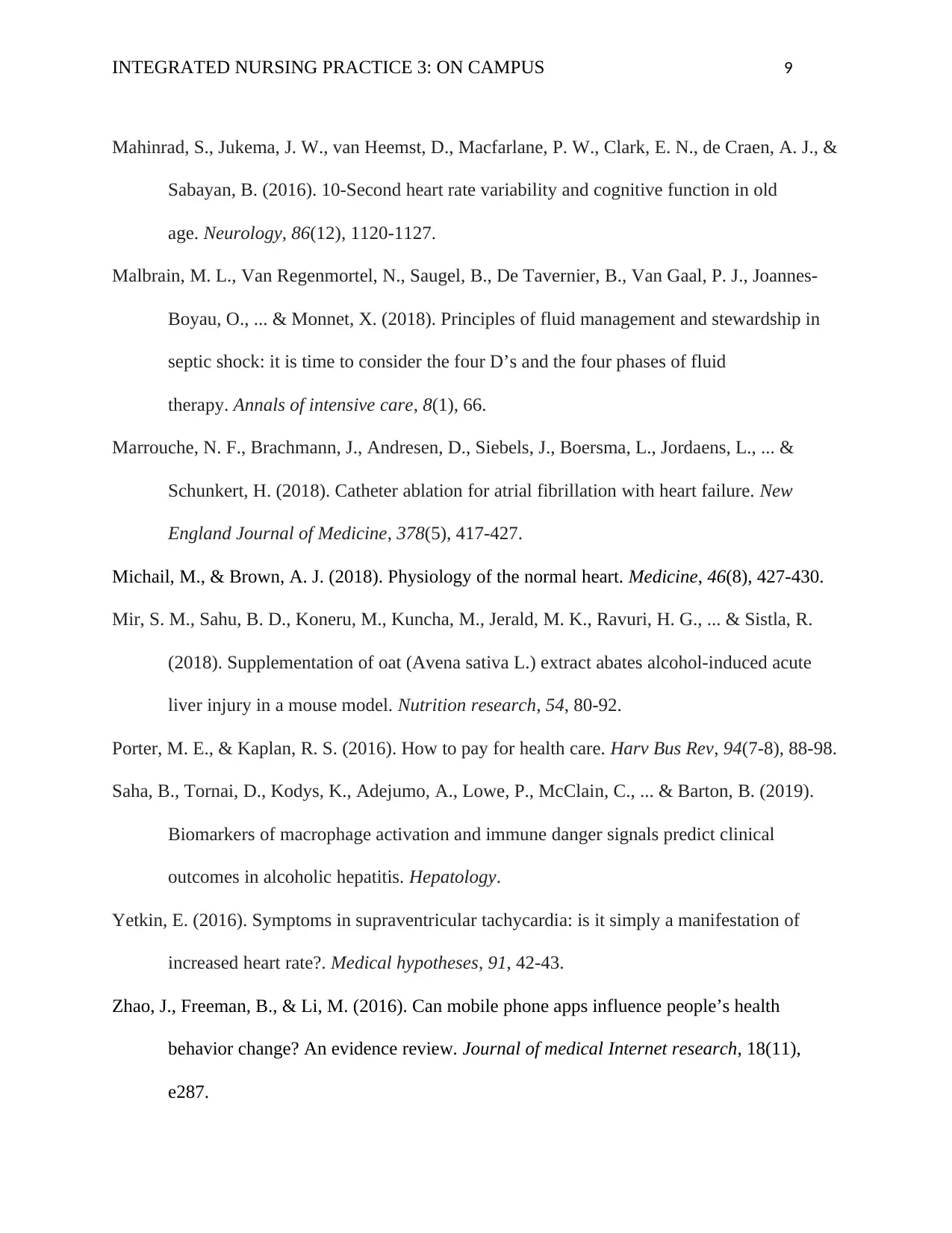
INTEGRATED NURSING PRACTICE 3: ON CAMPUS 9
Mahinrad, S., Jukema, J. W., van Heemst, D., Macfarlane, P. W., Clark, E. N., de Craen, A. J., &
Sabayan, B. (2016). 10-Second heart rate variability and cognitive function in old
age. Neurology, 86(12), 1120-1127.
Malbrain, M. L., Van Regenmortel, N., Saugel, B., De Tavernier, B., Van Gaal, P. J., Joannes-
Boyau, O., ... & Monnet, X. (2018). Principles of fluid management and stewardship in
septic shock: it is time to consider the four D’s and the four phases of fluid
therapy. Annals of intensive care, 8(1), 66.
Marrouche, N. F., Brachmann, J., Andresen, D., Siebels, J., Boersma, L., Jordaens, L., ... &
Schunkert, H. (2018). Catheter ablation for atrial fibrillation with heart failure. New
England Journal of Medicine, 378(5), 417-427.
Michail, M., & Brown, A. J. (2018). Physiology of the normal heart. Medicine, 46(8), 427-430.
Mir, S. M., Sahu, B. D., Koneru, M., Kuncha, M., Jerald, M. K., Ravuri, H. G., ... & Sistla, R.
(2018). Supplementation of oat (Avena sativa L.) extract abates alcohol-induced acute
liver injury in a mouse model. Nutrition research, 54, 80-92.
Porter, M. E., & Kaplan, R. S. (2016). How to pay for health care. Harv Bus Rev, 94(7-8), 88-98.
Saha, B., Tornai, D., Kodys, K., Adejumo, A., Lowe, P., McClain, C., ... & Barton, B. (2019).
Biomarkers of macrophage activation and immune danger signals predict clinical
outcomes in alcoholic hepatitis. Hepatology.
Yetkin, E. (2016). Symptoms in supraventricular tachycardia: is it simply a manifestation of
increased heart rate?. Medical hypotheses, 91, 42-43.
Zhao, J., Freeman, B., & Li, M. (2016). Can mobile phone apps influence people’s health
behavior change? An evidence review. Journal of medical Internet research, 18(11),
e287.
Mahinrad, S., Jukema, J. W., van Heemst, D., Macfarlane, P. W., Clark, E. N., de Craen, A. J., &
Sabayan, B. (2016). 10-Second heart rate variability and cognitive function in old
age. Neurology, 86(12), 1120-1127.
Malbrain, M. L., Van Regenmortel, N., Saugel, B., De Tavernier, B., Van Gaal, P. J., Joannes-
Boyau, O., ... & Monnet, X. (2018). Principles of fluid management and stewardship in
septic shock: it is time to consider the four D’s and the four phases of fluid
therapy. Annals of intensive care, 8(1), 66.
Marrouche, N. F., Brachmann, J., Andresen, D., Siebels, J., Boersma, L., Jordaens, L., ... &
Schunkert, H. (2018). Catheter ablation for atrial fibrillation with heart failure. New
England Journal of Medicine, 378(5), 417-427.
Michail, M., & Brown, A. J. (2018). Physiology of the normal heart. Medicine, 46(8), 427-430.
Mir, S. M., Sahu, B. D., Koneru, M., Kuncha, M., Jerald, M. K., Ravuri, H. G., ... & Sistla, R.
(2018). Supplementation of oat (Avena sativa L.) extract abates alcohol-induced acute
liver injury in a mouse model. Nutrition research, 54, 80-92.
Porter, M. E., & Kaplan, R. S. (2016). How to pay for health care. Harv Bus Rev, 94(7-8), 88-98.
Saha, B., Tornai, D., Kodys, K., Adejumo, A., Lowe, P., McClain, C., ... & Barton, B. (2019).
Biomarkers of macrophage activation and immune danger signals predict clinical
outcomes in alcoholic hepatitis. Hepatology.
Yetkin, E. (2016). Symptoms in supraventricular tachycardia: is it simply a manifestation of
increased heart rate?. Medical hypotheses, 91, 42-43.
Zhao, J., Freeman, B., & Li, M. (2016). Can mobile phone apps influence people’s health
behavior change? An evidence review. Journal of medical Internet research, 18(11),
e287.
⊘ This is a preview!⊘
Do you want full access?
Subscribe today to unlock all pages.

Trusted by 1+ million students worldwide
1 out of 9
Related Documents
Your All-in-One AI-Powered Toolkit for Academic Success.
+13062052269
info@desklib.com
Available 24*7 on WhatsApp / Email
![[object Object]](/_next/static/media/star-bottom.7253800d.svg)
Unlock your academic potential
Copyright © 2020–2025 A2Z Services. All Rights Reserved. Developed and managed by ZUCOL.





